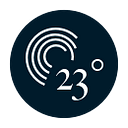#Howto create a bar chart with 23° | EN/GER
Für Deutsche Version nach unten scrollen
All you need to do is upload & save the data set. Click “continue to visual” and select your preferred chart type. Then save your chart to activate the embed code.
Nonetheless there are a few things you might want to know about the way we process data in order to turn them into beautiful interactive charts or maps.
How does the data-table I want to upload have to look?
1. The wide-format
2. The long-format
Fortunately, it doesn’t matter which format your data has.
That’s because we automatically convert all data to the long-format to make processing easier. (Unless you turned off the “Autocreate Groups” function)
So what’s the difference?
The difference between wide and long format lays in the number of chart-types you can create once you have saved the dataset.
Turning the data into long-format by using our “Autocreate Groups” function leaves you with more options because -as the name implies- it automatically creates groups, which can be helpful when applying filters or creating grouped, or stacked bar charts.
How do I create a grouped or a stacked bar chart then?
In contrast to a “regular” bar chart, a grouped or stacked bar chart represents at least 2 groups .
“simple bar chart”
Gender; Age
male; 20
Female; 30
“grouped bar chart”
Gender; City; Age
male; Vienna; 20
male; Berlin; 30
Female; Vienna; 30
Female; Berlin; 40
Let me give you an example:
For this chart we first used the wide format.
Since no groups are created this way, we can still only display a simple bar chart — or donut for that matter. You can only select one out of the two value fields (Age female or Age male).
We now use the same data set and turn it into the long format with the “Autocreate Groups” function.
The two columns “Age female” and “Age male” now become one “Group” column. Both cities Vienna & Berlin are now assigned a value for the male group and the female group.
#German#
Das Erstellen von Balken- und Säulendiagrammen mit 23 ° ist mit wenigen Klicks möglich.
Dazu musst du lediglich die Daten hochladen und deinen bevorzugten Diagrammtyp auswählen.
Wie muss die Datentabelle aussehen, die ich hochladen möchte?
1. Wide-Format
2. Long-Format
Glücklicherweise spielt es keine Rolle, welches Format deine Daten haben.
Das liegt daran, dass wir alle Daten automatisch in das Long-Format konvertieren, um die Verarbeitung zu vereinfachen. (Außer du deaktivierst die Funktion “Autocreate Groups”)
Was ist der Unterschied?
Der Unterschied zwischen Wide- und Longformat liegt in der Anzahl der Diagrammtypen, die du nach dem Abspeichern der Daten erstellen kannst.
Wenn die Daten mit unserer Funktion “Autocreate Groups” in ein Longformat umgewandelt werden, stehen dir mehr Darstellungsmöglichkeiten zur Verfügung, da — wie der Name schon sagt — automatisch Gruppen erstellt werden. Dies kann hilfreich sein, wenn du Filter anwenden oder gruppierte bzw. gestapelte Balkendiagramme erstellen möchtest.
Wie erstelle ich nun ein gruppiertes (grouped) oder ein gestapeltes (stacked) Balkendiagramm?
Im Gegensatz zu einem “normalen” Barchart stellst du bei einem grouped oder stacked Barchart mindestens 2 Gruppen dar. Das heißt dein Datenmodell sollte zumindest zwei Gruppen besitzen.
“einfaches Barchart”
Geschlecht;Alter
männlich;20
weiblich;30
"grouped Barchart”
Geschlecht;Bundesland;Alter
männlich;Wien;20
männlich;Oberösterreich;30
weiblich;Wien;30
weiblich;Oberösterreich;40
Ein Beispiel:
Im diesem Datensatz haben wir zuerst das Wide-Format benutzt.
Da so keine Gruppen erzeugt werden, können wir weiterhin nur einfache Balkendiagramme darstellen. Der angezeigte Wert (Alter Männlich oder Alter Weiblich) kann nur vorab im Editor ausgewählt werden.
Den selben Datensatz bringen wir nun mit der “Autocreate Groups” Funktion ins Long-Format.
Aus den beiden Spalten “Alter Männlich” und “Alter Weiblich” wird nun eine Spalte “Group”. So kann den Bundesländern jeweils ein Wert für die Gruppe Männlich und die Gruppe Weiblich zugewiesen werden.
